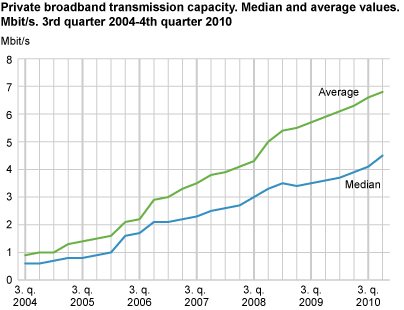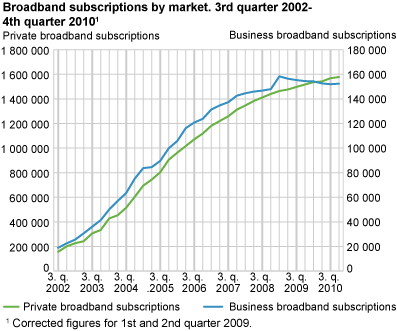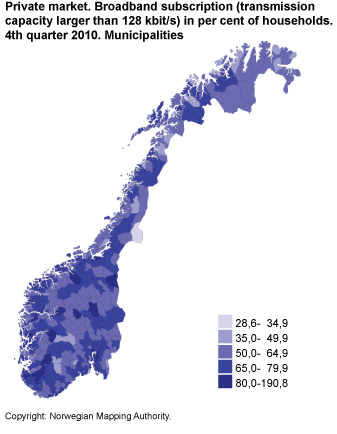Content
Published:
This is an archived release.
Steady development towards faster broadband
The average broadband capacity for private subscriptions increased to 6.8 Mbit/s in the 4th quarter of 2010. The annual growth rate in the number of fixed broadband subscriptions was 4 per cent.
The average transmission capacity for fixed private broadband has increased to 6.8 from 6.6 Mbit/s in the previous quarter. At the same time, the median value has increased slightly, to 4.5 Mbit/s compared to 4.1 in the previous quarter. With a few exceptions, the growth rate in capacity has been quite steady from 2004.
Private broadband subscriptions with a capacity of more than 8 Mbit/s total 30 per cent; an increase from 28 per cent in the previous quarter. Only 16 per cent of business broadband subscriptions have this capacity; an increase from 15 per cent in the previous quarter.
The number of broadband subscriptions with fixed access on the Norwegian mainland was 1 730 000 at the end of the 4th quarter of 2010; an increase of 59 000 subscriptions in the last 12 months. Compared to the previous quarter, this is an increase of 10 000 subscriptions. Almost the whole increase in the last quarter relates to private subscriptions, while business subscriptions gained 400. At the end of the 4th quarter, Norway had 1 578 000 fixed private broadband subscriptions and 152 000 business subscriptions.
Low growth rate in fixed broadband subscriptions related to households
The broadband penetration rate in private households is 73 per cent; an increase from 72 per cent in the previous quarter. Compared to last year there is an increase from 71 per cent. The figure for private broadband subscriptions per 100 households varies between 78 per cent in the county of Akershus and 60 per cent in the county of Finnmark.
| Centrality1 | Broadband subscriptions | Broadband subscriptions as a percentage of households | |||||||||||||||||||||||||||||||||||||||||||||||||||||||||||||||||||||||||||||
|---|---|---|---|---|---|---|---|---|---|---|---|---|---|---|---|---|---|---|---|---|---|---|---|---|---|---|---|---|---|---|---|---|---|---|---|---|---|---|---|---|---|---|---|---|---|---|---|---|---|---|---|---|---|---|---|---|---|---|---|---|---|---|---|---|---|---|---|---|---|---|---|---|---|---|---|---|---|---|---|
| Remote municipalities | 127 312 | 64 | |||||||||||||||||||||||||||||||||||||||||||||||||||||||||||||||||||||||||||||
| Fairly remote municipalities | 86 959 | 68 | |||||||||||||||||||||||||||||||||||||||||||||||||||||||||||||||||||||||||||||
| Fairly central municipalities | 257 043 | 70 | |||||||||||||||||||||||||||||||||||||||||||||||||||||||||||||||||||||||||||||
| Central municipalities | 1 106 335 | 75 | |||||||||||||||||||||||||||||||||||||||||||||||||||||||||||||||||||||||||||||
| 1 | 1 Centrality 2008, Municipalities 2008. |
The most central municipalities have the highest number of broadband subscriptions relative to the number of households. While the number of broadband subscriptions relative to the number of households is 75 per cent, the corresponding figure for less central municipalities is 64 per cent.
In some municipalities the number of leisure time cottages is high compared to the number of ordinary households. As the number of fixed broadband subscriptions to these cottages increases, the figure for subscriptions relative to the number of households may become extremely high. One out of three municipalities with a broadband penetration rate over 80 per cent belong to this group.
Mobile broadband instead of fixed access
Although Statistics Norway has no figures to confirm this, it appears that mobile broadband access in some sparsely populated municipalities has become the most relevant alternative for broadband access instead of fixed radio access or cabled technologies. This information came to light as a result of the process of checking the data regarding the municipality with the lowest penetration rate of all; Lierne, with only 29 fixed broadband accesses per 100 households.
| Municipalities | Broadband subscriptions as a percentage of households | ||||||||||||||||||||||||||||||||||||||||||||||||||||||||||||||||||||||||||||||
|---|---|---|---|---|---|---|---|---|---|---|---|---|---|---|---|---|---|---|---|---|---|---|---|---|---|---|---|---|---|---|---|---|---|---|---|---|---|---|---|---|---|---|---|---|---|---|---|---|---|---|---|---|---|---|---|---|---|---|---|---|---|---|---|---|---|---|---|---|---|---|---|---|---|---|---|---|---|---|---|
| $Average for all municipalities | 72.7 | ||||||||||||||||||||||||||||||||||||||||||||||||||||||||||||||||||||||||||||||
| 0941 Bykle | 190.8 | ||||||||||||||||||||||||||||||||||||||||||||||||||||||||||||||||||||||||||||||
| 0215 Frogn | 99.9 | ||||||||||||||||||||||||||||||||||||||||||||||||||||||||||||||||||||||||||||||
| 0521 øyer | 93.5 | ||||||||||||||||||||||||||||||||||||||||||||||||||||||||||||||||||||||||||||||
| 1046 Sirdal | 93.3 | ||||||||||||||||||||||||||||||||||||||||||||||||||||||||||||||||||||||||||||||
| 1232 Eidfjord | 92.4 | ||||||||||||||||||||||||||||||||||||||||||||||||||||||||||||||||||||||||||||||
| 1018 Søgne | 92.4 | ||||||||||||||||||||||||||||||||||||||||||||||||||||||||||||||||||||||||||||||
| 1121 Time | 91.2 | ||||||||||||||||||||||||||||||||||||||||||||||||||||||||||||||||||||||||||||||
| 0213 Ski | 90.9 | ||||||||||||||||||||||||||||||||||||||||||||||||||||||||||||||||||||||||||||||
| 0926 Lillesand | 89.5 | ||||||||||||||||||||||||||||||||||||||||||||||||||||||||||||||||||||||||||||||
| 1640 Røros | 89.2 | ||||||||||||||||||||||||||||||||||||||||||||||||||||||||||||||||||||||||||||||
| 0544 øystre Slidre | 87.8 | ||||||||||||||||||||||||||||||||||||||||||||||||||||||||||||||||||||||||||||||
| 1252 Modalen | 87.0 | ||||||||||||||||||||||||||||||||||||||||||||||||||||||||||||||||||||||||||||||
| 1151 Utsira | 85.6 | ||||||||||||||||||||||||||||||||||||||||||||||||||||||||||||||||||||||||||||||
| 0216 Nesodden | 85.6 | ||||||||||||||||||||||||||||||||||||||||||||||||||||||||||||||||||||||||||||||
| 1241 Fusa | 84.8 | ||||||||||||||||||||||||||||||||||||||||||||||||||||||||||||||||||||||||||||||
| 1563 Sunndal | 84.5 | ||||||||||||||||||||||||||||||||||||||||||||||||||||||||||||||||||||||||||||||
| 1601 Trondheim | 84.0 | ||||||||||||||||||||||||||||||||||||||||||||||||||||||||||||||||||||||||||||||
| 0230 Lørenskog | 83.5 | ||||||||||||||||||||||||||||||||||||||||||||||||||||||||||||||||||||||||||||||
| 1926 Dyrøy | 83.3 | ||||||||||||||||||||||||||||||||||||||||||||||||||||||||||||||||||||||||||||||
| 0217 Oppegård | 82.6 | ||||||||||||||||||||||||||||||||||||||||||||||||||||||||||||||||||||||||||||||
| 1246 Fjell | 82.2 | ||||||||||||||||||||||||||||||||||||||||||||||||||||||||||||||||||||||||||||||
| 0701 Horten | 82.0 | ||||||||||||||||||||||||||||||||||||||||||||||||||||||||||||||||||||||||||||||
| 1516 Ulstein | 81.6 | ||||||||||||||||||||||||||||||||||||||||||||||||||||||||||||||||||||||||||||||
About calculation of median and averageMedian value is the value that divides the population in two equal parts -those with higher and those with lower values. In the calculation of the median value it is postulated that the subscriptions in the capacity band of 4-8 Mbit/s divide themselves evenly on all values in this group. In the calculation of averages it is postulated that the subscriptions also divide themselves evenly in all the other groups. |
|
The mobile broadband access was removed because this part of the statistics is not complete and because these subscriptions cannot be distributed geographically and by download capacity in the same way as the fixed access subscriptions. The Norwegian Post and Telecommunications Authority also compiles statistics on these mobile subscriptions but without information about the geographical location or download capacity. The number of Internet service providers reporting to this survey has been around 200 over the past few years. Market changes have reduced this number to around 180. A few small, but locally important Internet service providers, mostly cable TV providers, are still not included in the survey. Efforts have been made to include these providers. Some small errors related to the distribution of subscribers between municipalities may occur. This can have major consequences for the figures per household for some municipalities. The number of households for 2010 has been used in these statistics. Individuals and businesses can have several Internet subscriptions and several individuals can use the same subscription. The number of subscriptions is therefore not equivalent to the number of households/businesses with Internet access. A household can for instance get Internet access through an employer, educational institution or by sharing access with other households. The survey ICT in households provides more information about households with at least one member under the age of 75 with Internet access. For more information, see About the statistics . |
Tables:
- Table 1 Private broadband subscriptions. Subscription by transmission capacity and county including Svalbard. 4th quarter of 2010
- Table 2 Business broadband subscriptions. Subscription by transmission capacity and county including Svalbard. 4th quarter of 2010
- Table 3 Development features. Broadband subscription by market. Active subscriptions only. The whole country without Svalbard
- Table 4 Broadband subscriptions (larger than 128 kbit/s). Business and private subscriptions. 4th quarter 2010. Municipality
Contact
-
Statistics Norway's Information Centre
E-mail: informasjon@ssb.no
tel.: (+47) 21 09 46 42



